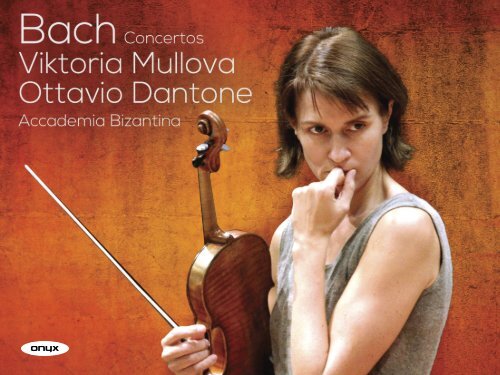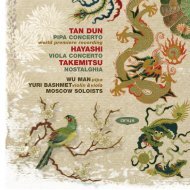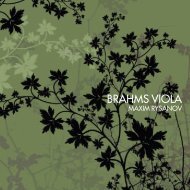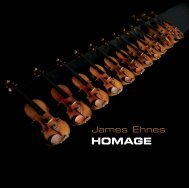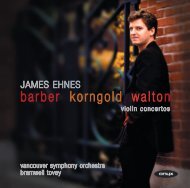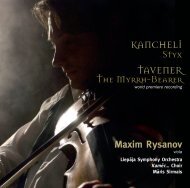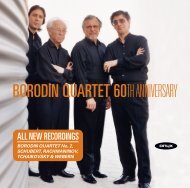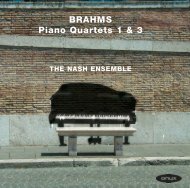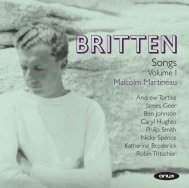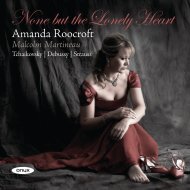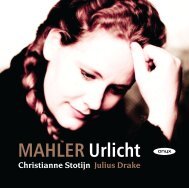Create successful ePaper yourself
Turn your PDF publications into a flip-book with our unique Google optimized e-Paper software.
The partnership of <strong>Viktoria</strong> <strong>Mullova</strong> and Ottavio Dantone has already resulted in a highly acclaimed set of Bachsonatas for violin and keyboard. This time they join forces with Accademia Bizantina in a programme of Bachviolin concertos: two famous ones, and two which are better known in different guises.JOHANN SEBASTIAN BACH (1685–1750)Violin Concerto in E BWV 10421 I Allegro 7.262 II Adagio 5.253 III Allegro assai 2.34Concerto for harpsichord in E BWV 1053, arr. for violin in D4 I Allegro 8.225 II Siciliano 5.116 III Allegro 6.06Violin Concerto in A minor BWV 10417 I Allegro 3.348 II Andante 5.149 III Allegro assai 3.29Concerto for two harpsichords in C minor BWV 1060,arr. for violin and harpsichord10 I Allegro 4.5211 II Adagio 4.4412 II Allegro 3.29Total timing: 60.31<strong>Viktoria</strong> <strong>Mullova</strong> violinAccademia BizantinaOttavio Dantone directorZ LC 19017 ONYX 4114 & 2013 VIKTORIA MULLOVA UNDER EXCLUSIVE LICENCE TO PM CLASSICS LTD. ALL RIGHTS OF THE MANUFACTURER AND OF THE RECORDED WORK RESERVED.UNAUTHORISED HIRING, LENDING, PUBLIC PERFORMANCE, BROADCAST AND COPYING OF THIS RECORDING PROHIBITED. MADE IN THE EU
Bach and transcriptionFrom the end of the 16th century, musicians and theoreticiansperfected a system of codes for expression and compositionthat contributed tothe spread of a shared language. It was common practice toadapt musical scores to the players and instruments availableon any given occasion.Bach’s music lends itself particularly well tosuch adaptation: his works are so structurally and conceptuallyperfect that they transcend soundand timbre. Many can be played on any instrument withoutaltering their intrinsic value. Bach was famously wont to reusehis own music in different instrumental or indeed vocalcombinations.<strong>Viktoria</strong> and I agreed that it would be interesting to focus onthe practice of transcription, accompanying two originalconcertos, BWV 1041 and BWV 1042, with two newly transcribedcompositions. We opted for the Concerto BWV 1053, written forharpsichord in E major, but reused by Bach himselfin two cantatas, and probably originally intended for oboed’amore. I immediately thought of transcribing it in D major, notonly because the brighter key suits the violin, but also becauseits astounding central Siciliano features a glorious melody thatsuits the violin perfectly.<strong>Viktoria</strong> and I, having often performed the sonatas for violinand harpsichord, were keen to find a piece we could play withorchestra. One concerto is particularly well suited to this idea,BWV 1060. The original version is for two harpsichords andstrings, though Bach first drafted it for two violins, or for violinand oboe. I feel this unprecedented version works very well,enriching the composition with a range of new nuances.Key here is not only the reality of performance, but also theunderlying aesthetic concept: rigour of form and musicallanguage, together with inventive brilliance in performance, werefeatures of the 18th century. Once we understand exactly howand why these expressive forms came about and interacted,the entire period comes magically to life.© Ottavio Dantone, 2013Bach und die TranskriptionSeit Ende des 16. Jahrhunderts schufen Theoretiker undMusiker, um zu einer wahren und gemeinsamen Sprache zugelangen, ein System kompositorischer Regeln, das auf denAusdruck zielte. Es war bekanntlich üblich, Partituren der Anzahlund auch Art der zur Verfügung stehenden Instrumenteanzupassen.Bachs Werke eignen sich besonders gut, transkribiert zuwerden: Seine Musik weist über sich hinaus und setzt sich überjede Äußerlichkeit oder klangliche Festlegung hinweg, da sie inForm und Anlage vollkommen ist. Viele seiner Werke könnenunbesorgt auf einem beliebigen Instrument ausgeführt werden,ohne dass sich ihr innerer Wert veränderte. Bach pflegtebekanntlich einen großen Teil seiner Musik bei anderenGelegenheiten wieder zu verwenden, auch in seinen Kantaten.Wiktorija und mir kam der Gedanke, die Praxisder Transkription ins Licht zu rücken, indem wir zwei originaleKonzerte, BWV 1041 und 1042, mit zwei neuen Bearbeitungenvergleichen. Die Wahl fiel auf das Konzert BWV 1053, das in E-dur für Cembalo geschrieben war und von Bach noch einmal inzwei Kantaten verwendet wurde, ursprünglich aber wohl fürOboe d’amore bestimmt gewesen war. Ich hatte sofort die Idee,das Werk in die Tonart D-dur zu transkribieren, in der die Violinebrillanter hervortritt, aber der Hauptgrund für diese Wahl warder erstaunliche Mittelsatz (Siciliano), der mit seinerwunderschönen Melodielinie für die Eigenschaften der Violinewie geschaffen ist.Wiktorija und ich haben unzählige Male Bachs Sonaten fürVioline und Cembalo aufgeführt und wollten gerne ein Stückfinden, das wir gemeinsam mit Orchester aufführen können. Esgibt ein Konzert, das sich dafür hervorragend eignet, dasKonzert BWV 1060. Die Originalfassung ist für zwei Cembali undStreicher, war von Bach aber für zwei Violinen, oder Violine undOboe, skizziert worden. Diese Version, wie man sie noch nieversucht hat, bereichert meiner Meinung nach diesewunderschöne Komposition um neue Facetten.Es gilt nicht nur über die Aufführungspraxis nachzudenken,sondern auch über das ästhetische Konzept: Strenge von Form
und Sprache im Verein mit ideenreicher interpretatorischerGestaltung zeichnen das 18. Jahrhundert aus. Wenn es unsgelingt, die Bedeutung dieser Ausdrucksformen zu ermessen,dann offenbart sich uns diese Zeit mit all ihrem Zauber.Ottavio DantoneÜbersetzung: Gudrun MeierBach et la transcriptionDès la fin du XVI e siècle, les théoriciens et les musiciens avaientmis au point un système de codes, autant pour la compositionque pour l’expression, qui avait permis d’établir un véritablelangage commun.Il était d’usage d’adapter la partition que l’on jouait auxinstruments que l’on avait à sa disposition.La musique de Bach se prête particulièrement bien auxadaptations : elle ne dépend pas de l’apparence extérieure etdu timbre mais les transcende, étant parfaite sur le plan de laconception et de la structure. On peut jouer beaucoup de sesœuvres sur n’importe quel instrument sans altérer leur valeurintrinsèque.Bach réutilisait souvent sa musique en changeantles effectifs, par exemple dans ses cantates.<strong>Viktoria</strong> et moi-même avons eu l’idée de mettre en lumière lapratique de la transcription. Nous avons ainsi juxtaposé deuxconcertos originaux, les BWV 1041 et 1042, à deux adaptations.Notre choix est tombé sur le Concerto pour clavecin BWV 1053en mi majeur, réutilisé par Bach dans deux cantates etprobablement destiné à l’origine au hautbois d’amour. J’ai toutde suite pensé le transcrire enré majeur, une tonalité plus brillante au violon. Le mouvementcentral bouleversant (Siciliano) est d’ailleurs à mon avisparfaitement adapté aux caractéristiques du violon par sasuperbe ligne mélodique.Nous avons joué les sonates pour violon et clavecin de Bachde nombreuses fois, <strong>Viktoria</strong> et moi-même, et nous noussommes dit que ce serait formidable de trouver un morceauque nous puissions jouer ensemble avec l’orchestre. Il existeun concerto qui répond parfaitement à ce souhait,le BVW 1060. La version originale est pour deux clavecins etcordes, mais Bach a d’abord esquissé l’œuvre pour deux violonsou pour violon et hautbois. À mon avis, cette version inéditeenrichit cette œuvre superbe de nouveaux atours.Cet enregistrement invite à réfléchir non seulement sur lespratiques d’exécution, mais aussi sur une esthétique : la rigueurde la forme et du langage, alliée à la fantaisie de l’interprétation,sont typiques du XVIII e siècle. Lorsqu’on réussit à comprendreles gestes de cette époque, ses modes de fonctionnement etses signifiants, elle se révèle à nous dans toute sa forcefascinante.Ottavio DantoneTraduction : Daniel Fesquet
Other Bach recordings from <strong>Viktoria</strong> <strong>Mullova</strong> on ONYXONYX 4020Bach: Sonatas<strong>Viktoria</strong> <strong>Mullova</strong> · Ottavio DantoneONYX 4040Bach: Solo Violin Sonatas and Partitas<strong>Viktoria</strong> <strong>Mullova</strong>Executive producer for ONYX: Matthew CosgroveProducer: Fabio FrambaBalance engineer: Roberto ChinellatoMixing and mastering: Andrew MellorRecording location: 1–5 December 2012, Sala Oriani in Bagnacavallo, Ravenna, ItalyPhotography: Max PucciarielloDesign: Jeremy Tilston for WLP Ltdwww.onyxclassics.comwww.viktoriamullova.comwww.accademiabizantina.it


